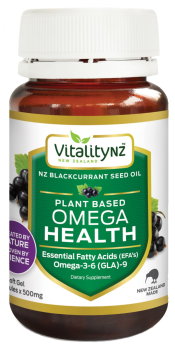Not all dietary fat is bad for your health – far from it. Fat comprises a whopping 60% of our brains and our intake of dietary fat greatly influences the proper function of this vital organ. Essential Fatty Acids (EFAs) are prime among these healthy fats, and in the right quantities, the health benefits they endow can be life-changing. From better moods to clearer skin, their positive effects extend throughout the entire body.
Unknown to many, EFAs consist of a big family of dietary fats, named Omega Fatty Acids. They affect the body in a variety of ways and are found in many different foods. Most are considered essential nutrients, meaning the body cannot produce them on its own, despite needing them to attain good health.
To unlock the health benefits of EFAs, let’s break down the most important Omega groups and where they naturally occur. And then, allow us to let you in on a little secret about how to optimize your intake of all three.
Omega-3 Fatty Acids
This family of EFAs makes up over 84% of the brain’s fatty acids, and for this reason, it’s widely considered to be the most important of the fatty acids. Unfortunately, most human beings are not consuming nearly enough Omega-3s and this can lead to many chronic diseases as well as poor weight management.
The brain and cell membranes thrive on these healthy fats and a dietary supplement including Omega-3s is highly recommended to most. Otherwise, they must be consumed through food sources such as salmon, sardines, walnuts, chia seeds, and blackcurrants.
Benefits:
- Lower blood pressure and support heart health.
- Support mental health and reduce symptoms of schizophrenia, depression, and bipolar disorder.
- Aid weight management
- Decrease fat in the liver
- Support brain development in infants and children
- Slow the onset of dementia
Omega-6 Fatty Acids
Just like Omega-3, the body cannot produce Omega-6 on its own. However, the good news is that Omega-6 is much easier to consume in the diet, as it is present in many vegetable oils commonly used for cooking. To reap the rewards of these EFAs, one should maintain the recommended ratio of 4:1 for Omega-6 to Omega-3 Fatty Acids.
Benefits:
- Reduces the risk of heart disease
- May reduce the risk of cancer
- Supports healthy levels of cholesterol
Omega-9 Fatty Acids
Unlike Omegas 3 and 6, this fatty acid is not considered an essential nutrient because the body can produce it with the right ‘building blocks.’ However, there are still great benefits to be had from consuming Omega-9 in the diet. You can find Omega-9 in many foods containing the other EFAs as well as olive oil, canola oil, macadamia nuts, and avocados.
Benefits:
- Higher energy levels
- May enhance moods
- Supports healthy levels of cholesterol
 The Optimum Ratio of EFAs in Omega Health
The Optimum Ratio of EFAs in Omega Health
For your convenience, Omega Health delivers all three types of fatty acids in an optimum ratio, so you don’t need to go out of your way to make changes to your diet.
As the EFAs are sourced from blackcurrants, Omega Health is a top choice for anyone following a vegan or vegetarian diet. With no fishy aftertaste and no bulky hard-to-swallow capsules, our blackcurrant Omegas are preferable to most.
This optimum ratio of Omegas also ensures they work effectively and do not produce adverse effects. Unknown to many, an imbalance can lead to inflammatory responses or at worst, chronic diseases. With Omega Health, you’re guaranteed all your Omega Fatty Acids in the right quantities for full support of the mind and body.
Get your bottle here.